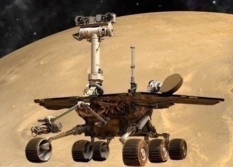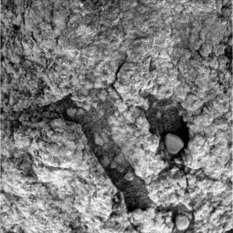A.J.S. Rayl • Jun 03, 2015
Mars Exploration Rovers Update: Opportunity Tours Spirit of St. Louis Crater
Sols 4006 - 4035
Opportunity spent a mostly merry month of May on Mars touring Spirit of St. Louis Crater, stopping at science targets named in honor of Charles Lindbergh and the incredible flight he took 88 years ago, a heroic feat that fired up the wanderlust for soaring through the skies and pushing the boundaries to do what no one else has done.
It was May 20, 1927. At 7:52 a.m., taking advantage of a break in rainstorms, Lindbergh, then 25 years old, gunned the engine of his privately funded, single engine, single seat, high-wing monoplane that he christened Spirit of St. Louis, and rumbled down a dirt runway at Roosevelt Field, in Long Island. He was competing for the Orteig Prize, a $25,000 cash award ($340,067 in 2015 dollars) offered by New York hotelier Raymond Orteig to the first allied aviator(s) to fly non-stop from NYC to Paris, or Paris to NYC.
Weighed down with 451 gallons of fuel, Spirit of St. Louis gathered speed slowly on the dirt runway, still soft from the rains. Many of the estimated 150 people who gathered to watch held their breaths. Six men attempting the flight had already died in three separate crashes.
Lindbergh’s airplane, which had been custom built for the flight by Ryan Airline Company in San Diego, California, passed the halfway mark on the field with enough speed to “clear the obstructions at the end,” he gauged. Within seconds, the Spirit of St. Louis was aloft, clearing a tractor at the end of the field by 15 feet, then a telephone wire just beyond by 20 feet “with a fair reserve of flying speed,” Lindbergh wrote later.
He was on his way. The eyewitnesses on the ground, as the stories go, believed they had just witnessed a miracle.
Somehow – despite a storm that threw him off course, no radar, which didn’t really exist then, no radio because of weight and no communications capability anyway over the ocean, and a bout of hallucinations likely caused by lack of sleep – somehow, 33 hours, 30 minutes, and 29.8 seconds after taking off from Roosevelt Field, Lindbergh put Spirit of St. Louis down at Le Bourget Field in Paris and completed the first-ever TransAtlantic flight. And he’d done it alone.
The crowd waiting his arrival went crazy, stampeding Lindbergh, pulling him from the plane. He hadn’t slept in 55 hours. Police had to rescue him and carry him to safe quarters. “Lucky Lindy” was an instant international hero, with fame the likes very few celebrities even now have experienced.
Launching on the “wings” of the Wright Brothers and their Flyer-1, Lindbergh not only pushed the boundaries with his Spirit of St. Louis, he transcended them, with unflinching courage, precision engineering, meticulous checklists, and heavily calculated strategy.
Spirit of St. Louis is “flying” still at the Smithsonian National Air & Space Museum in Washington DC and Lindbergh’s solo flight has gone down in history as one of the most magnificent achievements of the 20th Century.
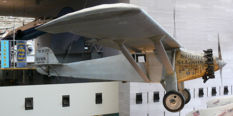
Spirit of St. Louis
On May 20-21, 1927, Charles Lindbergh made the first TransAtlantic flight in a single engine, high-wing monoplane custom built for the trip by Ryan Airline Company. "The Spirit of St. Louis is a wonderful plane," Lindbergh wrote after the flight. "It’s like a living creature, gliding along smoothly, happily, as though a successful flight means as much to it as to me, as though we shared our experiences together, each feeling beauty, life, and death as keenly, each dependent on the other’s loyalty. We have made this flight across the ocean, not I or it."Smithsonian / Ad Meskens
Every flight that challenges Earth’s limitations and pushes the boundaries – including and perhaps especially the MER mission – launches on the “wings” of Lindbergh and his Spirit of St. Louis. Interestingly, there are a number of parallels in these two enterprising, magical missions 77 years apart.
The MER team and their Opportunity and Spirit rovers made it to Mars against all odds, just like Lindbergh and Spirit of St. Louis succeeded in flying from New York to Paris. When Spirit and Opportunity were zapped by the largest solar flare recorded to date en route to Mars, it could have caused electronic hallucinations that like Lindbergh’s own physiological hallucinations could have been mission catastrophic, but the adventurers recovered to complete their objectives and become pioneers, the first in their sector of the world of air and space to do what they did.
No one really believed Lindbergh could make it to Paris and no one really believed Spirit and Opportunity would successfully land and complete their scheduled 3-month tours.
When Lindbergh did touch down in Paris, it was viewed as a miracle. He became a hero like no other, his picture and accounts of his flight on every newspaper front page around the world, the banner of radio news broadcasts everywhere. And when Spirit and then Opportunity bounced to landings on Mars in January 2004, there were a lot of people at JPL who thought they may have witnessed a miracle two times over.
Backed by a charismatic commander in chief and a team of thousands of human colleagues, the rovers became instant robot heroes. More than 1.2 billion people jammed the NASA and JPL websites in the first 72 hours to see the images streaming down from Mars through a pipeline that Steve Squyres, MER’s principal investigator, generously, gratefully opened to the world. And there's more.
Just as the Lone Eagle’s TransAtlantic flight was an epic event that initiated the Lindbergh Boom in aviation, the MER landings electrified public interest in planetary exploration. Perhaps most intriguing, most uncanny in terms of parallels though is that the MER team members bonded with Spirit and Opportunity, the robots they imbued with their own human traits and hopes and dreams, so much like Lindbergh had with his Spirit of St. Louis that one is left to wonder.
In May, the MER team and Opportunity paid tribute. "The MER team stands on the shoulders of many giants of exploration and discovery and we were delighted to shift into a naming convention based on one of the great adventurers who proceeded us, Charles Lindbergh, and the flight of the Spirit of Saint Louis aircraft – what a great tribute to an amazing feat," said Ray Arvidson, MER deputy principal investigator of Washington University St. Louis.
All in all, May was another workaday month for Opportunity. Despite some more annoying computer issues, the veteran rover carried on with the planned science campaign inside Spirit of St. Louis Crater the small, oblong-shaped crater near the entrance to Marathon Valley. As the robot field geologist roved from one rock to another target, she roved and worked “fantastically well,” said Bill Nelson, chief of MER engineering at the Jet Propulsion Laboratory (JPL), home to all of NASA’s Mars rovers.
After driving into the crater at the end of April, Opportunity closed in on Lindbergh Mound on the first of May and conducted an up-close inspection of a rock dubbed Roosevelt Field. Looking like some kind of rock spire or a fallen cairn built and abandoned on a beach somewhere, Lindbergh Mound is a formation that the MER scientists have described as “strange” and “bizarre” and “weird.”
“And it still is," said Arvidson. “We're in the process of trying to finish up all the measurements, but so far Lindbergh Mound and Spirit of St. Louis Crater remain very enigmatic features.”
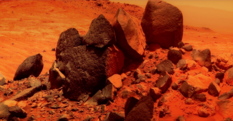
Lindbergh Mound
Opportunity took this image of a strange stack of rocks inside Spirit of St. Louis Crater, now forever to be known as Lindbergh Mound, with her Pancam. Stuart Atkinson, MER poet, planetary author and educator, processed this Pancam image in his Martian 'technicolor' style. For more of Atkinson's work on MER, check out his: The Road to Endeavour.NASA / JPL-Caltech / Cornell / ASU / S. Atkinson
The MER scientists are working with a number of different hypotheses. It could be that Spirit of St. Louis Crater is a secondary impact, perhaps from the impact event that created Bopolu Crater far to the southwest of Opportunity, which would suggest Lindbergh Mound is a pile of ejecta from Bopolu. Or the crater could be evidence of volcanic activity.
“The big mound looks like very fine-grained igneous rocks, but we don't know that for sure,” said Matt Golombek, MER project scientist at JPL. “We have chemical readings from it and the rocks are distinct from the breccias we found outside the crater, and we're trying to sort it out.”
Opportunity has seen a lot of breccias along the eroded western rim of Endeavour Crater, which she has been exploring since August 2011. Somewhat surprisingly, an awful lot of breccias dot this area and they all appear to rocks composed of broken fragments of minerals and/or other rocks cemented together during the impact event that created Endeavour Crater 3 to 4 billion years ago.
From Lindbergh Mound, Opportunity moved on to Harold Bixby an outcrop on the floor of the crater, near the crater’s southeastern rim, and found more breccia. The robot field geologist then drove to a small ridge or knoll in the crater, what geologists call a hummocky area. They named it Donald A. Hall, after the designer who with Lindbergh designed the Spirit of St. Louis. It, too, was more breccia.
One of the big mysteries is that Opportunity has still not roved on any of the oldest Matijevic Formation strata, the oldest bedrock found on any Mars surface mission. The rover discovered this ancient bedrock during her search expedition at the Cape York segment of Endeavour’s eroded western rim back in 2011. “That has been an interesting surprise on our part,” said Golombek. “And we keep wondering and in fact thinking scientifically about what the structure of the Endeavor crater rim must be for us to not be seeing those older rocks.”
Operationally, everything was going well in May. Opportunity continued to produce a healthy amount of power through her solar arrays under typically dusty summer skies. And then mid-month those pesky memory issues returned. The robot suffered two amnesia events, which were minor and annoying. No science was lost. No big deal and the rover didn’t skip a beat. But when she had three more sudden, unexpected warm reboots, that ratcheted up concern. The assumption is that there's still some issue with the rover’s flash drive that triggers these events, but it’s all still under investigation.
There had been some desire to finish up work in Spirit of St. Louis Crater before the end of May and direct Opportunity into Marathon Valley for a walkabout, but with the variety of targets inside the small crater and solar conjunction coming in June, that was not to be.
Solar conjunction is a regular celestial event that occurs once every 26 months or so, when the orbits of Earth and Mars align the two planets on opposite sides of the Sun. This alignment disrupts radio transmissions between the two planets so all Mars missions initiate what effectively is a communications blackout. The MER team has scheduled its blackout from June 3rd to June 24th.
During the last week of May, the MER team made a decision to take flash offline for safety sake. “Because of the amnesia events and what appeared to be two more resets, we put the vehicle in what we call persistent RAM mode, and we're going to stay in this mode through solar conjunction,” said Nelson.
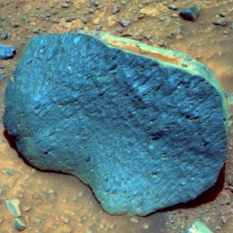
Roosevelt Field
Opportunity took this image of Roosevelt Field with her Panoramic Camera (Pancam) in early May 2015. The image, processed by the Pancam team, is presented here in false color, a technique that enables scientists to compare and discern different geologic features.NASA / JPL-Caltech / Cornell / ASU
The MER team just doesn’t want to take any chances. “Because of the amnesia events and what appeared to be two more resets, we put the vehicle in what we call persistent RAM mode, and we're going to stay in this mode through solar conjunction,” Nelson said.
“Every time the rover does something, it gives us more information,” added Bekah Sosland, MER flight director who is also leading the flash tiger team investigating Opportunity’s long-term memory issues. “We don't want to be on the other side of the Sun if the rover may have another warm reset.”
During this solar conjunction, Opportunity will work on an ultralight science campaign, basically on 'autopilot,’ following commands being uploaded as this MER Update goes to posting. Since RAM mode is volatile, unlike the non-volatile flash memory, that means the rover will have to uplink all data collected each sol or Martian day to Mars Odyssey for storage, because once the rover goes to sleep the data will not be there when it wakes up.
Back in March, Opportunity and her software team successfully reformatted the flash drive, masking off a corrupted sector, known as bank 7. The rover returned to using six banks of storage in the drive and everything was operating perfectly fine for a few weeks, and things are better now. “The problems aren't as bad as they were before masking off bank 7, Sosland pointed out. “Flash has been behaving. It's just not behaving ideally,” she said.
A few MER veteran engineers who were there at the “birthing” of Spirit and Opportunity, have put together a fishbone diagram, a visualization tool for categorizing the potential causes of a problem in order to identify its root causes. Now, together with the flash tiger team, they’re picking through the bones, so to speak. “We are working now to see if we can identify the actual causes of what we're seeing so that we can at least understand what’s going on, maybe mitigate it, or even recover from it,” said Nelson.
Opportunity kept on trucking. She left Donald A. Hall and drove west out of Spirit of St. Louis Crater, then north around its rim. By May 27th, the robot was at a rock dubbed Private William Bratton, after a member of the Corps of Discovery, better known as the Lewis & Clark Expedition. The rock is in the red ring of material that appears here and there around the rim of the small crater.
As May gives way to June, the Sun sets on another “really good” month for Opportunity. “The rover is operating just fine, past the amnesia events and reboots,” said Golombek. “We're going and doing the business that we're supposed to be doing which is looking at the rocks and exploring the region,” he said. “And so yeah, all's great.”
The plan forward is that the rover will settle in next to Private William Bratton for solar conjunction, through most of June, taking measurements on a chosen spot to determine the rock's chemical composition.
"We've configured the rover to go through solar conjunction without using flash memory so we can ensure its stable operation under sequence control and we do have some modest science planned for the solar conjunction phase," summed up John Callas, MER project manager at JPL. "We're looking forward to the rest during solar conjunction, because we can stand down. And then, we're excited about resuming operations after solar conjunction and heading into Marathon Valley."
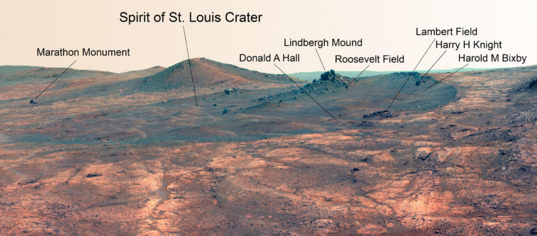
NASA / JPL-Caltech / Cornell / ASU
Martian Tribute to Pioneering Flight
Names related to the first solo nonstop flight across the Atlantic have been informally assigned to a crater NASA's Opportunity Mars rover is studying. This false-color view of the Spirit of St. Louis Crater and the Lindbergh Mound inside it comes from Opportunity's panoramic camera.When May dawned at Endeavour Crater, Opportunity woke up inside Spirit of St. Louis Crater, the small, geological "foyer" of Marathon Valley. After taking some routine images of the surroundings with her Panoramic Camera (Pancam), she was ready to begin her exploration of this puzzling little crater.
With its strange stack of dark rocks, forever to be known as Lindbergh Mound, the crater seemed to promise to be a highlight in her expedition of discovery along the eroded western rim of the big crater, Endeavour.
Opportunity had just driven into the formation the sol before and on Sol 4006 (May 1, 2015), she made a dogleg approach to Lindbergh Mound. At drive's end, she took the routine post-drive Navigation Camera (Navcam) panoramas.
The next sol, the robot field geologist aimed her Alpha Particle X-ray Spectrometer (APXS) to measure atmospheric argon, part of a mission-long study on the Martian atmosphere. Later that night, the rover attempted to capture a Phobos eclipse with her Pancam. "Unfortunately, the sequence to image the Martian moon late in the day on Sol 4007 was apparently shut down early, presumably because of thermal constraints on the rover, and so we were not able to image the event," reported Jim Bell, the lead scientist on the Pancam and President of The Planetary Society. "Sometimes these things happen, especially when attempting challenging observations, and we'll continue to try to image future Phobos and Deimos events."
Now in position at the mound, Opportunity began a close-up investigation of a rock called Roosevelt Field. Using her Microscopic Imager (MI), the robot took the series of pictures for a mosaic of the target. Then, following what has long been the standard science investigation protocol, she placed her APXS on the same spot for a multi-hour integration to determine the rock’s chemical composition.
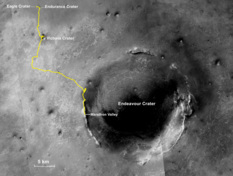
Opportunity's route so far
The gold line on this image, courtesy Larry Crumpler of the New Mexico Museum of Natural History and Science, shows Opportunity's route from the Eagle Crater landing site to her approximate current location. Since August 2011, the MER mission has been investigating the western rim of Endeavour Crater, which spans about 22 kilometers (about 13.7 miles) in diameter. The base image for the map, all within the Meridiani Planum region of equatorial Mars, is a mosaic of images taken by the Context Camera onboard the Mars Reconnaissance Orbiter (MRO).NASA /JPL-Caltech / MSSS / NMMNHS
Roosevelt Field, like Sgt. Charles Floyd, a rock Opportunity checked out along Endeavour’s western rim in March, appear blue in the Pancam false color images. Since everything on Mars is pretty much varying shades of rusty red, the rocks are not really blue, but false coloring is a technique that enables the scientists to more easily discern different geological elements in image.
Turns out Roosevelt Field is similar to Sgt. Charles Floyd, “but not the same,” said Arvidson.
Opportunity finished out the first week of May roving and taking pictures with both her Pancam and Navigation Camera (Navcam). On Sol 4011 (May 6, 2015), she drove 7.6 meters (about 25 feet), to approach an outcrop on the floor of the crater, named Harold M. Bixby, after one of the financiers of the Spirit of St. Louis and Lindbergh’s NY-Paris flight, and prepare for a close-up investigation.
On Sol 4013 (May 8, 2015), Opportunity took the usual MI pictures of the chosen spot on Harold M. Bixby for a mosaic, and then placed her APXS on the same spot for a multi-hour integration. The following sol, 4014 (May 9, 2015), the robot field geologist also spent some time looking around and taking some additional Navcam panoramas.
By Sol 4016 (May 12, 2015), her investigation of Harold M. Bixby was finished. The outcrop turned out to be "similar to material outside of the crater," said Arvidson. Opportunity took the usual pre-drive targeted Pancam color imagery and then roved on, taking a short jaunt, 9 meters (about 30 feet) to the south inside Spirit of St. Louis Crater.
The destination target was the hummocky terrain that the team named Donald A. Hall, after the pioneering aeronautical engineer-designer who designed the Spirit of St. Louis with Lindbergh. Following the drive, the rover took the usual post-drive Navcam panoramas. Then, on the morning of Sol 4017 (May 13, 2015), Opportunity experienced a sudden reboot about 30 seconds into the morning X-band uplink of commands via the high-gain antenna.
Just like the reboot in April, which had been the first since the rover reformatted her flash in March, the event record—or EVR—showed a bad address. Since it seemed to point to a range outside of any address space used by the rover’s avionics, it was confounding and frustrating. “Apparently somewhere in the code, a reference was created that points off into never-never land, to non-existent hardware,” said Nelson. “We still suspect that it is somehow related to the flash memory. But we still don’t know that yet," he said.
"One of the side effects of that warm reboot was the loss of the HGA gimbal angles, which set us up for an X-band fault on the next use of the HGA on Sol 4018," Nelson continued. Then, about 30 seconds after the reboot, Opportunity experienced a flash block write error that was "seemingly fixed" by an automatic power cycle of the flash memory, he said.
The ops engineers turned their attentions to restoring Opportunity back to master sequence control, but an operational error prevented the use of the high-gain antenna on Sol 4018 (May 14, 2015). Maintaining communications with a rover on Mars isn't always a cakewalk.
"The team sent a real-time activation command to recalibrate the HGA to restore the gimbal angles," reported Nelson. "Unfortunately, the team sent an activate for the regular recalibration sequence instead of the fault recovery recalibration sequence. Since the HGA gimbal angles were lost on Sol 4017, the next use on Sol 4018 forced an X-band fault, which set a flag saying the HGA wasn’t usable. The recovery sequence resets this flag before recalibrating. The standard sequence does not. With the flag set, the standard sequence failed and no recalibration took place."
By Sol 4020 (May 16, 2015) however, Opportunity was back to normal operations and on that sol, she executed a very small turn-in-place, just 4.6 degrees, to position herself before a particular spot on Donald A. Hall. That evening, she worked in another overnight atmospheric argon measurement with her APXS.
The following evening, Sol 4021 (May 17, 2015), Opportunity suffered a bout of amnesia. Like most all the previous amnesia events, this one was benign with no loss of data, and the robot field geologist continued her science campaign inside Spirit of St. Louis Crater without missing a beat.
On Sol 4023 (May 19, 2015), the rover pulled out her Rock Abrasion Tool (RAT) to brush a spot on Donald A. Hall and clear the surface of accumulated dust. After the brushing, the robot followed the standard routine, taking the pictures needed with her MI for a large, close-up mosaic image of the target, and then she then placed her APXS on the spot for a multi-hour integration to determine its chemical makeup. It turned out to be more Shoemaker Formation breccia.
More than 11 years after landing and grinding into her first rock in Eagle Crater, Opportunity’s RAT is holding up remarkably well. “So far, we have performed four successful brushing operations this year and the RAT is still healthy and operating well,” said Gale Paulsen, Senior Systems Engineer at Honeybee Robotics and Spacecraft Mechanism Corporation, the company that created the rover’s rock abrasion tool. “We do still have approximately 25% of the bit life remaining and ready for future grinds,” added Paulsen, who oversees the rover’s RAT.

Solar conjunction
Solar conjunction is a regular celestial event that occurs once every 26 months or so, when the orbits of Earth and Mars aligns them on opposite sides of the Sun. During this time, the Sun disrupts radio transmissions between the two planets, so the MER team initiated a communications blackout from June 3-June 24 this year. Opportunity will essentially conduct work on 'autopilot' following commands uploaded before solar conjunction began.NASA / JPL-Caltech
It was designed for 90 sols work. Amazing. Even so, the MER scientists are choosing the targets for RAT grinding work very carefully, because “once we use the bit up – that's it for grinding,” said Golombek.
That same sol, however, Opportunity suffered another unexpected warm reboot. It was the third reboot since the rover and her team reformatted the flash drive and masked off bank 7 in March. But the sudden reboot on Sol 4023 was “an unusual case,” said Sosland, and along with it, she apparently another amnesia event.
"When the rover’s flight software came back up and tried to mount to Flash and couldn't it went into RAM mode,” she recounted. “What happened when it fell back to RAM mode is it started saving all of the event records, the EVRs, that would have showed us why it warm booted into RAM,” said Sosland. “When the rover unexpectedly warm resets, it comes back up in auto mode, and because there was no sequence onboard to keep it awake, it shut down and took a nap.”
Therefore, any hint as to why this sudden reboot happened, which may have been stored in RAM, was lost when the rover shut down and went to sleep that night because RAM is volatile memory.
In addition, since there was no recorded event of the warm reboot occurring, it wasn’t exactly easy to piece it all together. “In fact, I didn't even know the rover warm booted initially, because it didn't look like it did,” said Sosland. “It just looked like normal EVRs – except that there was a big gap in the events records and that indicates to us that the rover had amnesia during that time,” she explained. “When I went into that time period to investigate that missing data and saw that the rover was in auto mode, I suspected the warm boot because that's what would've kicked us into auto mode and it did. It was just hidden from us.”
But another sudden reboot on Sol 4026 (May 22, 2015) wasn't hidden. Opportunity had her APXS placed on Donald A. Hall.
“The fact that Opportunity continues to have problems with, we suspect, the flash memory is very frustrating; however, this didn't come as a huge surprise,” said Sosland. “We knew that masking off bank 7 [on the flash drive] was our next step in trying to figure out how to solve this problem. But because we don't have very much insight into what's going on, we suspected that this could have spread to other issues in flash or it could be something else.”
“The good news is that these problems keep occurring has actually given the engineering team more insight into what is actually happening on Opportunity,” Sosland continued. “We now have our tactical team of engineers on MER currently and a whole other team, the flash experts who worked with this rover back in the beginning, looking into all these events. We’re taking one step back and looking at the whole picture of what's going on with the flash memory on Opportunity.”

Fishbone - Ishikawa diagram
A fishbone diagram is a visualization tool for categorizing the potential causes of a problem in order to identify its root causes. It was created by Kaoru Ishikawa in 1968. Some of the MER team's original software designers have created a fishbone diagram to try and help determine why Opportunity continues to have issues with her flash memory after a successful reformatting in March 2015.Daniel Penfield via Wikipedia Commons
Although the final count for May was just two amnesia events and three sudden reboots, there may have been additional, “more subtle” events, said Nelson. “It’s going to take some digging to find out for sure what's going on and so we'll continue doing analysis.
Opportunity could easily continue her expedition of Endeavour Crater without flash, however, having that extra long-term memory space is a luxury the team would like to save, because it affords the opportunity for taking more large panorama images. “We are taking this very seriously,” said Nelson.
The team is contemplating doing some testing on the ground rover. Meanwhile, some of the veteran MER engineers – Jim Donaldson, Glenn Reeves, Todd Litwin, Alan Lee, and Tracy Nielson – completed their fishbone diagram of the rover’s software, which they began work on in April.
Also known as an Ishikawa or cause and effect diagram, a fishbone diagram looks at different parts and factors, like workmanship, operation, hardware, and software to identify causes and effects, and the cascade of those causes and effects that ultimately lead to a failure. “The way it is diagrammed, with a central failure and then branches off it at slight angles with potential major causes, and then branching again with minor causes, and then branching again at a diagonal, still lesser things, it looks kind of like, well, fishbones,” said Nelson.
Meanwhile, the MER scientists are working through the science evidence and trying to write the story of this Spirit of St. Louis. Crater So far, the plot is anything but obvious. While Roosevelt Field is similar to Sgt Charles Floyd, the rest of the interior rocks “are like the rocks on the outside,” said Arvidson. Which surprised most of the MER scientists.
“We looked at three or four different rocks on the outside of Spirit of St. Louis Crater and they all appear to be breccias, related to what we call Shoemaker Formation, which are presumably the breccias that formed when the Endeavor crater formed,” said Golombek. “And we have not seen any of the older rocks from the Matijevic Formation, that we saw at Cape York, which has been an interesting surprise for us."
In fact, they haven't seen anything but breccias since Cape York. "If you think about the rim of Endeavour, the impact would have broken up and jostled areas," Golombek said. "We keep wondering and in fact thinking scientifically about what the structure of the Endeavor crater rim must be for us to not be seeing those older rocks. That's sort of what we're trying to come to terms with.”
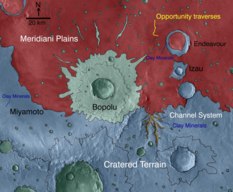
Geologic map of Meridiani Planum
This map indicates geological units in the region of Mars around a smaller area where Opportunity has driven from early 2004 through late 2010. The blue-coded unit encompassing most of the southern half of the mapped region is ancient cratered terrain. In the northern region, it is overlain by younger sediments of the Meridiani Plains, punctuated by the even younger Bopolu impact. Could the impact that created Bopolu have sent rocks as far as Spirit of St. Louis Crater? At Endeavour Crater, in the upper right near the gold line of the rover's traverse, ancient cratered terrain is exposed around the crater rim. The scale bar is 20 kilometers (12.4 miles).NASA / JPL-Caltech / JHUAPL / WUSTL
“It's sort of in the details of how much erosion has occurred to the crater since it formed,” offered Golombek. “Typically after an impact, there's a kind of fold over flap on the rim that occurs at the end of crater formation. Here, from what we're seeing now it appears to be breccias. But with the amount of erosion that we would guesstimate, we expected to see some of those older rocks poking through. But we haven't seen the older rocks.”
The MER scientists have two primary working hypotheses. One theory is that Spirit of St. Louis Crater was formed by a secondary low velocity, low angle impact from whatever created Bopolu Crater, another large, 20-kilometer diameter crater far to the southwest of the rover’s current location. Bopolu is younger than Burns Formation, which could explain, perhaps, the breccias found inside Spirit of St. Louis Crater and in the apron just outside being Burns Formation, suggested Arvidson. Lindbergh Mound then would theoretically then be a pile of ejecta from Bopolu.
But Lindbergh Mound could also theoretically be a volcanic neck of magma that froze, meaning Spirit of St. Louis Crater might be volcanic in origin. “In some ways, an impact origin is unlikely with a mound that big in the middle with big, black, dark rocks,” said Golombek. “If that central mound is volcanic, then that would suggest maybe it was a crater to start and then there's been subsequent volcanic activity or it's some kind of a ring dike or a ring volcanic structure of some sort. Whatever it was, the initial form is probably gone, because it's been eroded down and that makes it kind of tough.”
For now, Spirit of St. Louis Crater remains a mystery story to be continued, but the scientists have only begun to dig into the data Opportunity has sent home. As for the rover, it was time to move on.
She drove west out of Spirit of St. Louis Crater, then north around the rim on Sol 4029 (May 26, 2015) for 47.97 meters (about 157.4 feet). Two sols later, 4031 (May 28, 2015) Opportunity put another 19.03 meters (62.4 feet) on her rocker bogie "to put red rim rocks underfoot," as Nelson put it.
The robot field geologist perched over the rock the team named for Private William Bratton to take a good, long close-up look.
In April, the team was thinking that Opportunity would finish up work in Spirit of St. Louis Crater and drive into Marathon Valley, do a walkabout, and find nice, north facing slopes to wait out solar conjunction. But it wasn't a plan that was absolutely necessary. “The real requirement is to be in Marathon Valley by the winter because it has north-facing slopes,” said Golombek. "We talked about being in Marathon Valley by conjunction, but there was never any real requirement to be there. “The fact of the matter is the way we can interact with the spacecraft and what we can do with the spacecraft over conjunction didn't really make it very important to be anywhere special during that time.
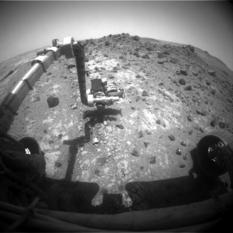
Checking out Priv. Wm Bratton
Opportunity roved up to a rock in a red rim of material that can be seen in different parts of the rim of Spirit of St. Louis Crater. The team named the rock Private William Bratton, after a member of the Lewis & Clark Expedition. With solar conjunction on its way, the rover will be spending most of June hunkered down over the rock trying to analyze its chemical composition.NASA / JPL-Caltech
Indeed, the solar conjunction science campaign will be ultralight. “We're limited to only getting about six or seven and maybe as much as eight megabits per sol and for us about five megabits of that is going to be in engineering,” said Nelson. “That doesn’t leave a lot left for science.”
So, Opportunity will stay parked at Private William Bratton analyzing its chemical composition. “Our intent over the conjunction is to look at this red alteration zone at the edge of the crater, so we can compare with the material inside the crater and the red rim around it. That's our goal,” said Golombek. “We might do a transect, from one side to the middle to the other side, and that would be finished up after conjunction basically.”
As for having to go back into RAM-only mode, “it hasn't had much impact,” said Golombek. “We know how to do that. We know what to do. It’s a testament to what a well-oiled machine we have here. So we're working and we're getting the business done that we need to do – and we are all looking forward to getting into Marathon Valley.”
Once solar conjunction is over, the rover will head east into Marathon Valley where they know evidence for various kinds of clay minerals await their arrival. The most recent spectral results from the Compact Reconnaissance Imaging Spectrometer for Mars (CRISM) onboard the Mars Reconnaissance Orbiter, for which Arvidson is a co-investigator, show what looks like maybe three or four different clay-bearing minerals in the valley and on the floor.
“It could be pretty darn interesting when we get in there,” said Golombek, echoing every other scientist on the team.
"The big event after solar conjunction is to get moving and get into Marathon Valley," affirmed Callas. "We want to do a quick walkabout of Marathon Valley before winter sets in, which is next January and, tick tock, it will be here before we know. We'll get a little rest during solar conjunction and then we'll be raring to go."
It won’t be much longer. Opportunity, the rover that loves to rove, will no doubt be raring to go too. Her power production throughout May ranged from 508 to 536 watt-hours, more than half her full capability, while the atmospheric opacity or Tau bounced around a hazy 1.105 to 1.333. Her dust factor remained strong dust factor averaging 0.730.
As June peeked over the horizon, the robot field geologist was performing “exactly as you would want her to,” said Nelson. “Solar energy has been good. Mobility has been good. The science investigations have been good. There's absolutely nothing to complain about there,” Nelson summed up. “We are very happy with what Opportunity has been doing.”

NASA / JPL-Caltech / Cornell University / Arizona State University
Marathon Valley overlook
This view from Opportunity shows part of Marathon Valley as seen from an overlook north of the valley. The landscape is presented in false color, a process that makes it easier to see differences in surface materials. The scene spans from east, at left, to southeast and combines four pointings of the rover's Pancam on Mar.13, 2015, the rover's Sol 3958. The image combines exposures taken through three of the Pancam's color filters, centered on wavelengths of 753 nanometers (near-infrared), 535 nanometers (green) and 432 nanometers (violet), at each of the four camera pointings.Let’s Go Beyond The Horizon
Every success in space exploration is the result of the community of space enthusiasts, like you, who believe it is important. You can help usher in the next great era of space exploration with your gift today.
Donate Today

 Explore Worlds
Explore Worlds Find Life
Find Life Defend Earth
Defend Earth


